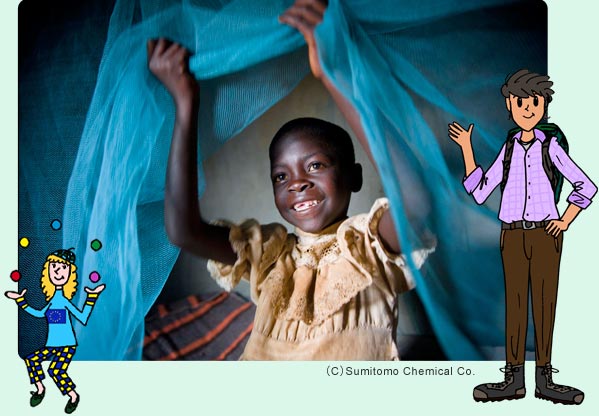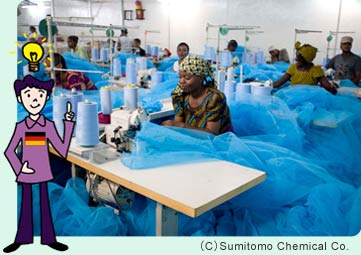
In Japan, mosquito nets that keep out insects while allowing ventilation came into wide use during the Edo period (1603-1867). The nets, made by weaving linen or cotton into a loose mesh, were draped around futons (sleeping mattress) to protect people from insect bites as they slept. They were a hallmark of summer. With the spread of glass windows, pesticides, and air conditioners, insects became less of a problem inside Japanese houses, and mosquito nets fell into disuse. By the end of the Showa era (1926-1989), they had almost completely disappeared and were a symbol of a bygone era.
Specially Treated Nets
Mosquito nets have recently received greater attention around the world as an effective tool in the fight against malaria. Malaria is a serious disease caused by the bite of a infected mosquito. Every year the disease is said to kill more than a million people worldwide, and in Africa a child dies of malaria every 30 seconds.
Sumitomo Chemical has developed a mosquito net treated with insecticide that has long-lasting repellant capabilities. In 2003 it succeeded in mass-producing the nets in Tanzania, and in 2007 a new factory was built there.
At the G8 Gleneagles Summit in July 2005, then Japanese Prime Minister Junichiro Koizumi announced a decision to distribute 10 million insecticide-treated bed nets in African countries by 2007 as a countermeasure to malaria, which kills a large number of children in Africa. Japan has distributed approximately 9.5 million mosquito nets (valued at approximately ¥6.7 billion) to 27 African countries as of August 2007 through the United Nations Children's Fund (UNICEF) mainly using grant aid, of which approximately 6.9 million nets were Sumitomo Chemical's Olyset ®Nets.

Battling Malaria
Thanks to efforts like this, the fight against malaria is making progress. In one region in Zimbabwe at risk to malaria outbreaks, for example, the ratio of children sleeping under a mosquito net is said to have risen from 7% to 70% in just two years.
The World Health Organization, along with a number of other agencies, is undertaking the Roll Back Malaria campaign, which aims to halve the number of malaria deaths by 2010. Japanese manufacturers and their Japanese-made mosquito nets are contributing to the campaign.
Meanwhile, back in Japan the once-forgotten mosquito net has been making a comeback as an eco-friendly replacement for electric repellents.










